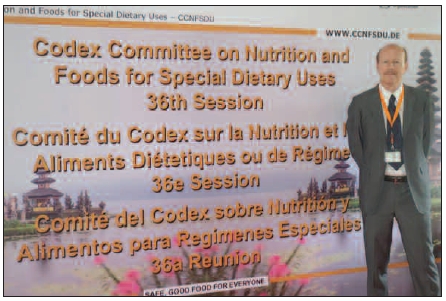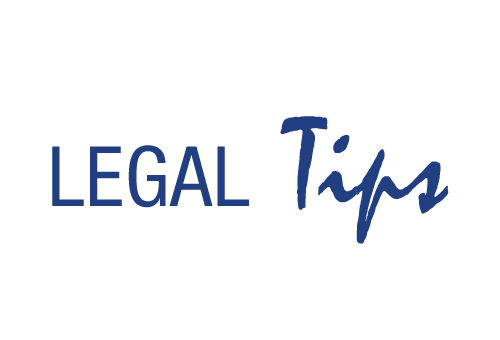Editor’s Note: This article is intended for information purposes only. Because state and municipal laws vary greatly, as do the circumstances of individual cases, readers are advised to contact an attorney for specific legal advice. © 2015 Scott C. Tips
Angelika Tritscher, the World Health Organization representative to Codex Alimentarius meetings, aptly posed a question to the Codex delegates assembled at a Food Contaminants meeting in Moscow last year, “How can we keep Codex relevant?” In posing this question, Dr. Tritscher quickly cut to the heart of the potential downfall of Codex. My response to Dr. Tritscher’s question was, “If Codex wants to remain relevant to consumers, then it must create food standards that are truly healthy and make sense.”
For more than five years now, the Codex Committee on Nutrition and Foods for Special Dietary Uses (CCNFSDU) has been working on establishing daily Nutrient Reference Values (NRVs) for essential vitamins and minerals. These NRVs would supposedly direct consumers as to healthy daily intake levels for vitamins and minerals such as vitamins A, C, D and E, calcium, magnesium, zinc, selenium and iron. But what the National Health Federation (NHF) found was that some Codex delegations led by Australia wanted to reduce virtually all of the recommended daily intake levels by significant percentages. The proposal for vitamin C, for example, was to reduce its NRV from a miserable intake level of 60 mg per day down to an even more ridiculous one of 45 mg per day! Fortunately, with the help of Iraq, India and the then-chairman Dr. Rolf Grossklaus, NHF was able to stop all advances in that direction at the 2009 committee meeting.
Since 2009, the Committee’s work on NRVs has proceeded at a snail’s pace year by year. However, at this year’s meeting, the 36th session of the CCNFSDU, the Codex delegates advanced almost all of the so-called “Batch 2” vitamins and minerals (vitamin C, selenium, zinc, molybdenum and manganese, but not iron and fluoride) midway up the eight-step approval process. Meeting in Bali, Indonesia during the entire Thanksgiving week 2014, the Codex delegates also deliberated further refinements to the wording of the “General Principles for the Addition of Essential Nutrients to Foods” as well as the necessity of Follow-up Formula for infants.
Garbage-In, Garbage-Out
In determining NRVs, Codex has decided to only consider science coming from a “Recognized Authoritative Scientific Body” (RASB). This would mean, for instance, such august bodies as the U.S. Institute of Medicine (IOM), the European Food Safety Authority (EFSA), the Australian National Health and Medical Research Council/New Zealand Ministry of Health (NHMRC/MOH), the Nordic Council of Ministers, the International Zinc Nutrition Consultative Group (IZiNCG) and the Japanese National Institute of Health and Nutrition (NIHN) are considered to be the sole repositories of nutritional knowledge that Codex should consult in establishing its standards and guidelines.
This approach is not entirely without reason since some of these RASBs, at various times, do generate valid scientific findings. EFSA, for instance, despite its recent stumbling on the aspartame safety issue, has been solidly against aluminum as a food additive. And IOM, in turn, even if belatedly, did decide to fortify foods with folic acid to reduce the incidence of spina bifida/anencephaly.
Still, the problem with all of these institutions is that they are far more often on the wrong side of science when it comes to human nutrition than on the right side. With their toxicological (i.e., pharmaceutical) mindset that treats all vitamins and minerals as if they were highly toxic substances until proven otherwise, these institutions ignore millennia of human nutritional experience. Even worse, they fail to distinguish among the many different forms of a nutrient, treating, for example, ferrous sulfate the same as carbonyl iron, or vitamin D3 as if it were the same molecule as vitamin D2.
The result of this blinkered approach to nutritional review is that incredibly safe vitamin and mineral forms are lumped in together with the potentially toxic forms, which when considered together results in unhealthy limits being imposed upon the safe, usually natural vitamin and mineral forms that our bodies have adjusted to after millennia of consumption by billions of humans. Indeed, government research has shown that vitamins and minerals are at the top of the list when it comes to safe consumer products.
So, even though Codex prides itself on being a science-based body, and obtaining its scientific information from only those RASBs that are the elite of the elite, as a practical matter, if the information that is churned out by those RASBs is based upon incorrect assumptions and models, then—even assuming the most rigorous, transparent, and unbiased scientific review—there is no way that the RASBs’ scientific numbers can be trusted.
This untrustworthiness can be readily seen from just looking at a few of the NRVs proposed by the RASBs for various vitamins and minerals. These are “Recognized,” “Authoritative,” “Scientific” Bodies that actually believe that the daily intake for vitamin C is adequate at 45 mg (Australia’s NHMRC and FAO/WHO), that humans can achieve optimal health on only 30 mcg of selenium a day (NHMRC and FAO/WHO), that vitamin D provides optimal health benefits at 400 IUs per day (virtually all RASBs), and that most of the B vitamins can be reduced in daily amount by at least 20–60% without harm (NHMRC, FAO/WHO and others). Astounding ignorance that passes as “science” in the 21st Century!
Couple the RASBs’ drug-mindset with their reviews of the least effective forms of the vitamins and minerals in order to establish “safe” upper and lower limits as well as their avoidance of any scientific studies that contradict that mindset and you have a recipe for nutritional disaster that actually makes humans less healthy. “Garbage-in, garbage-out” thus has a real-world impact that harms us all.
Vitamin-C Nutrient Reference Value
Only five years ago, I was arguing at Codex that it would become the laughing stock of the world if it put forth an NRV standard for vitamin C at 45 mg a day. Through NHF, I continued saying that, and much more, with the result being at this year’s meeting, the Committee approved without dissent a vitamin-C NRV that is 220% higher! Now, to be sure, at 100 mg per day, the vitamin-C NRV still leaves a lot to be desired, especially given the true multi-grams daily need for vitamin C; but to reverse the direction from downward to upward was a real achievement for our health. Interestingly enough, the 45 mg/day level for vitamin C was never again mentioned, left buried in the shallow grave where it so aptly belonged. And I am proud of the fact that NHF put it there.

|
|
| Scott Tips attends the most recent Codex meeting. |
However, most delegates—still uncritically genuflecting at the altar of FAO/WHO science—defer to FAO/WHO and the RASBs for the hard NRV numbers. Forgotten is the great World of Science that beckons beyond the narrow cultish confines of FAO/WHO science. NHF’s view is that when Codex considers adopting any standards, it should look far and wide at all pertinent science, whether it comes from FAO/WHO or not.
Some, such as Thailand, are almost insanely in favor of only coloring within the lines. Thailand’s Professor Tontisirin was obsessive about Codex only adhering to the One and True Religion of FAO/WHO science, rudely and childishly mocking NHF’s attempts, in this and other agenda items, to introduce other scientific viewpoints to Codex. Calling our science “nonsense,” he even went so far as to object to our expressed views being entered into the Final Report! Fortunately, the Codex Secretariat Tom Heilandt and the Chairwoman Pia Noble were fair and impartial here and refused to block them out of the report. Their politeness stood in sharp contrast to the Thai delegate’s rudeness.
Other NRVs
Vitamin C was not the only nutrient considered at this meeting. The NRVs for zinc, selenium, molybdenum, manganese, iron and fluoride were also reviewed. Over NHF’s objections, the zinc and selenium NRVs were set at 11–14 mg and 60 mcg, respectively. I argued that two values should be established for zinc to take into account the different intake needs for men and women, while with selenium, we argued for an NRV set at 70 mcg.1 There was some important support from the European Union for a 70-mcg level, but in the end the EU completely caved and did not insist upon its position, suddenly leaving the NHF high and dry. So, 60 mcg became the Committee’s recommended NRV for selenium, with 45 mcg for molybdenum and 3 mg for manganese.
Under the urgings of the European Union (EU), which is awaiting EFSA data on iron, the Committee deferred any action in setting an NRV for iron until the next meeting in 2015. As for setting an NRV for fluoride, most delegates (including NHF) opposed such an action, so it died a quick death. Significantly, during the discussion, the Togo delegate, Dr. Tchala Kazia, not only pointed out to the other delegates that fluoride is not an essential nutrient, but also “it might even have a negative impact on the structure of bones and teeth.”
At the 2015 CCNFSDU meeting to be held in Germany, the Committee will consider setting the NRVs for vitamin A, vitamin D, vitamin E, magnesium, phosphorus, chromium, copper, chloride and, finally, iron. It will be a significant meeting with a full plate for this agenda item.
Follow-Up Formula (FUF) for Infants
If anyone had thought the NRV agenda item was fraught with emotion, then they had never experienced a Codex discussion on infant and follow-up formulas. Showing up in full force for this discussion were the “baby formula” INGOs of International Baby Formula Action Network (IBFAN), International Lactation Consultant Association (ILCA) and the International Association of Consumer Food Organizations (IACFO) with their hands at the ready to push their buzzers to speak out on this issue.
The issue was, and still is, establishing standards for a formula that many see as nothing more than an added commercial niche for infant-formula companies such as Nestlé that would like to encourage maternal reliance upon formula even after weaning. Follow-up formula, the “baby formula” INGOs argued, is not nutritionally necessary, could cause confusion with infant formula, undermine the role of breastfeeding and is intended to replace healthy indigenous diets. Thanks to arguments researched and crafted by Katherine Carroll, the NHF supported these views, condemning those formulas tainted with GMO ingredients and also stating its agreement with the World Health Organization’s International Code of Marketing of Breast-milk Substitutes and its goal of working to support healthy breastfeeding practices in place of the reliance at any point in the nursing or weaning period on breast-milk substitutes.
A large number of African countries also opposed FUF, including Togo, Kenya, Senegal, Nigeria, South Africa and Sudan. Senegal in particular called follow-up formula “dangerous.” The WHO representative cautioned the Committee that it should be guided by the World Health Assembly’s clear statement that “the practice being introduced in some countries of providing infants with specially formulated milks (so-called ‘follow-up milks’) is not necessary.”2
Thailand, China, Korea, Canada and the United States, among others, supported moving forward with this formula work. Of course, the International Special Dietary Foods Industries (ISDI), which is filthy with Abbott, Nestlé, Mead Johnson and other formula pushers, argued the most strenuously in favor of follow-up formula.
In the end, the Chairwoman announced that while the Committee agreed with the opinion of WHO, it did not agree that a FUF standard was unnecessary and the work would therefore advance through an electronic Working Group (eWG) chaired by New Zealand. The eWG (in which NHF will participate fully) is to report back with its findings at the next CCNFSDU meeting, with a physical meeting of the Working Group to take place immediately before the regular Committee meeting.
Food Additives List
The Committee was also asked by the Commission and the Food Additives Committee to review certain food additives for inclusion or exclusion from the general list of approved food additives. While NHF objected to carrageenan’s inclusion in the list because of its potentially carcinogenic effects, it supported the retention of gum arabic and the gamma- and delta-tocopherol components of vitamin E. As no delegations (and this includes IADSA and CRN) supported NHF on its vitamin-E tocopherols position, the two were deleted from the list.
Carrageenan, however, remained on the list but with “death row” status pending a JECFA report due before the next meeting. Gum arabic was also retained because of the large number of delegations in favor of its retention.
Back to Dr. Tritscher’s Question
She asked, “How can we keep Codex relevant?” To my mind, Codex will survive another 50 years only through coercive force (governments imposing their standards and guidelines upon their citizenry) or through voluntary acceptance, that is creating standards that are healthy and actually make sense.
When, for example, Codex committees such as the Nutrition Committee ram through vitamin-and-mineral nutrient reference values that are pitifully weak, patently unhealthy and without true scientific support, then it undermines Codex’s credibility and relevance. It jeopardizes Codex’s future because nutritionally savvy people know those values are a joke and respect for anything Codex diminishes.
Part of the problem with Codex is that there are too many weak sisters like Professor Tontisiri, who are trapped in a scientific paradigm that only embraces “accepted” science. When confronted with a different paradigm (such as perhaps we should be striving for optimal health and not simply bare-subsistence nutrition), they lash out dogmatically at the optimal-health proponents. In doing so, they do a huge disservice to themselves, to Codex and most of all to the seven billion people on this planet who need or even crave the optimal nutrition that will enable them to function at more proficient levels and without those diseases that afflict sub-optimally fed populations.
In Carl Sagan’s last interview, he observed, “science is more than a body of information, it’s a way of thinking, of being skeptical.” Professor Tontisirin and others of his type degrade science and Codex by  rigidly adhering to a dogmatic interpretation of “science.” The World, and Codex, would be much better served if they would take Carl Sagan’s observations to heart. WF
rigidly adhering to a dogmatic interpretation of “science.” The World, and Codex, would be much better served if they would take Carl Sagan’s observations to heart. WF
A graduate of the University of California at Berkeley Law School, Scott C. Tips currently practices internationally, emphasizing Food-and-Drug law, business law and business litigation, trade practice, and international corporate formation and management. He has been involved in the nutrition field for more than three decades and may be reached at (415) 244-1813 or by e-mail at scott@rivieramail.com.
See www.wholefoodsmagazine.com/columns/legal-tips for additional Legal Tips columns.
End Notes
1 Specifically, I argued, “The NHF is one of the electronic Working Group members that did not accept the 60-mcg recommendation. Instead, the NHF agrees with the EU’s position on selenium as expressed in Conference Room Document 12 and we urge the Committee members to look carefully at the EU position expressed in this document. In particular, the EU points out that ‘Habitual selenium intakes of 50–60 mcg per day were not sufficient for SEPP1 concentration to reach a plateau in Finnish individuals, while a selenium intake of 100 mcg a day and above was consistently associated with plasma SEPP1 concentrations at a plateau in population groups from Finland, the UK and the US.’ The EFSA science is newer and more complete than the other data presented by the eWG and it should be considered in preference to the older data. We therefore urge that this Committee reject the 60-mcg level for selenium and adopt the 70-mcg level for more optimal health.”
2 World Health Assembly Resolution 39.28 (1986). See also WHA Resolution 63.23 (2010), in which WHA stated that the promotion of breast-milk substitutes and some commercial foods for infants and small children undermines progress in optimal infant and young-child feeding.
Published in WholeFoods Magazine, February 2015










